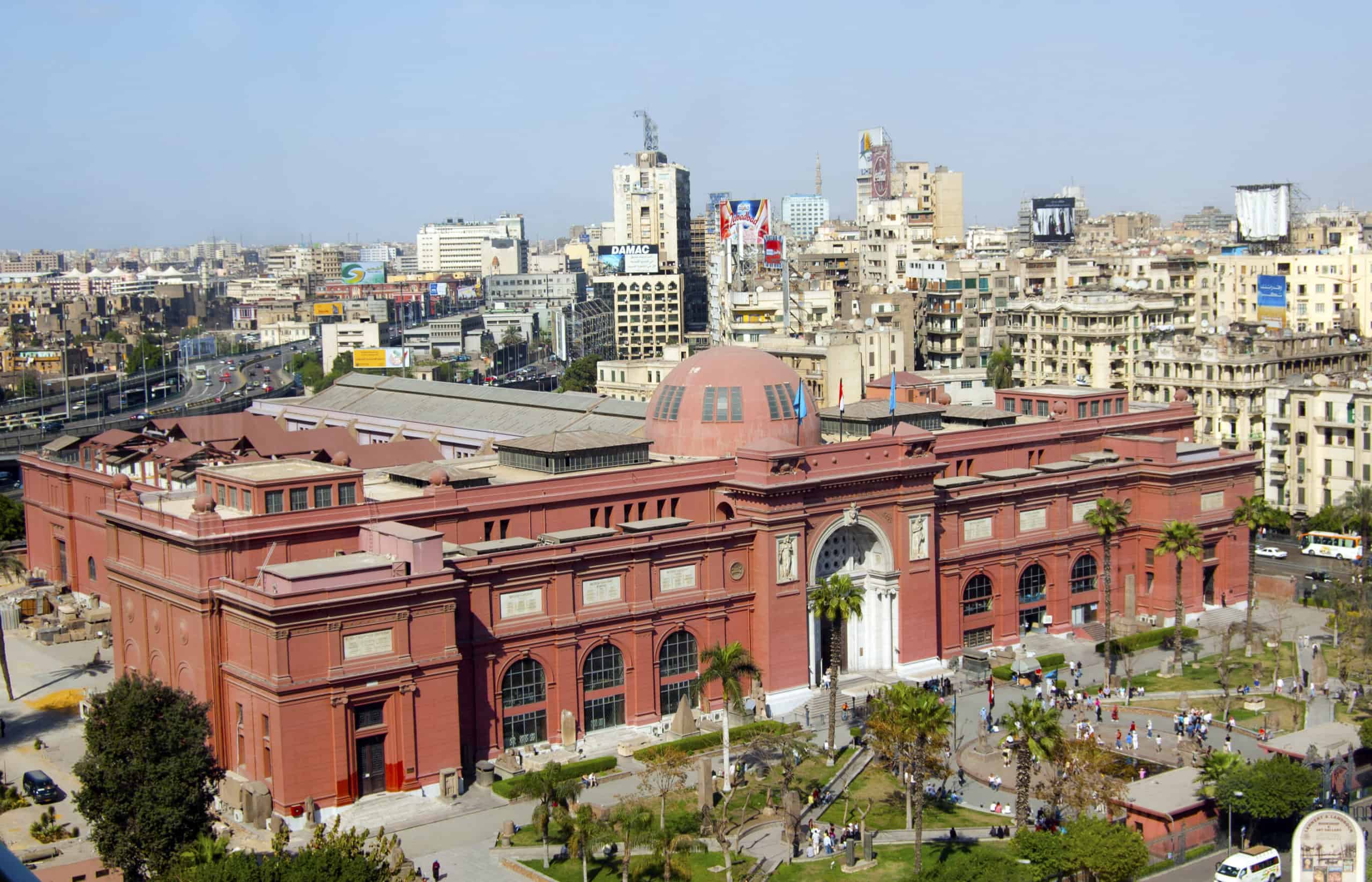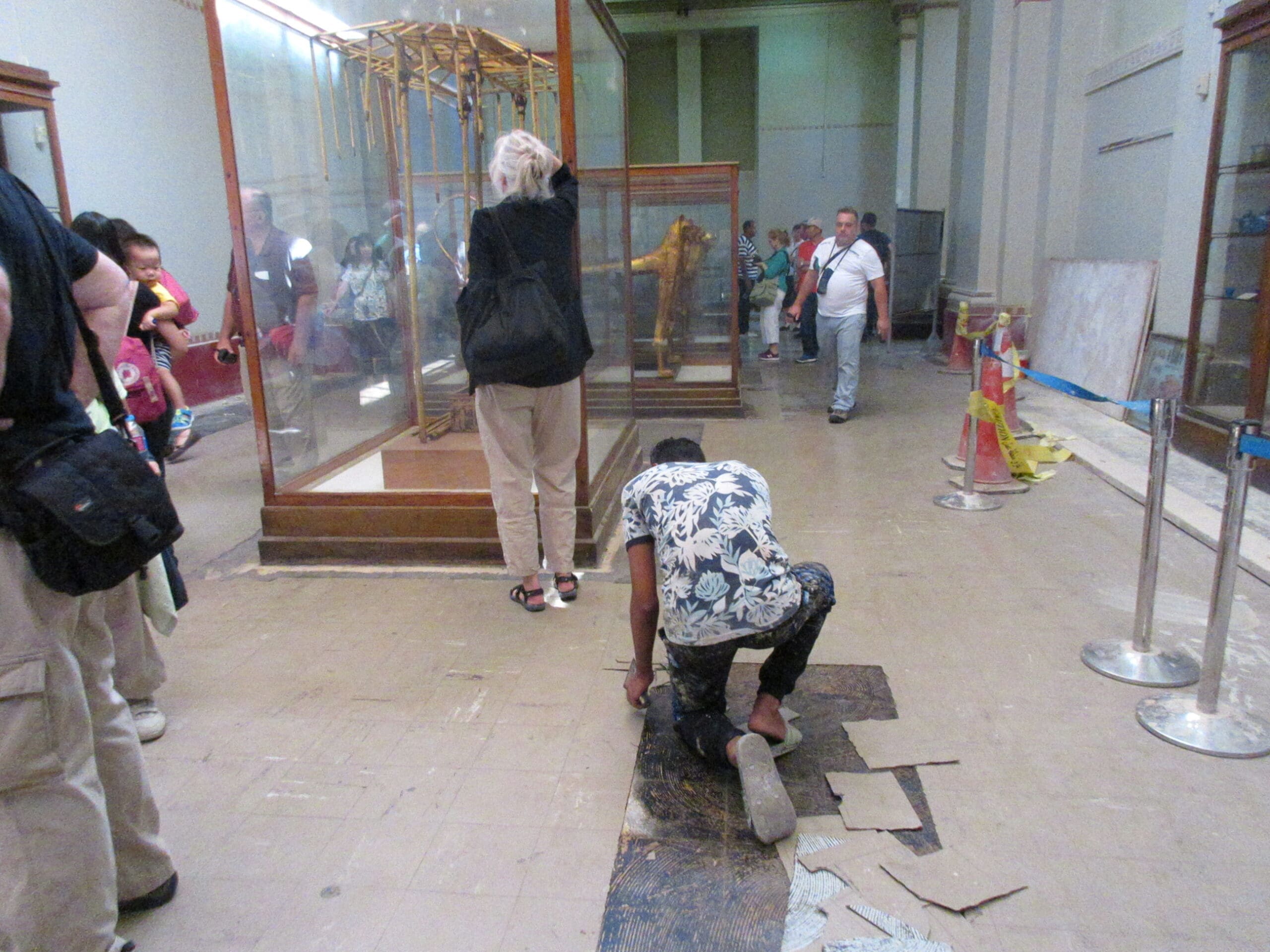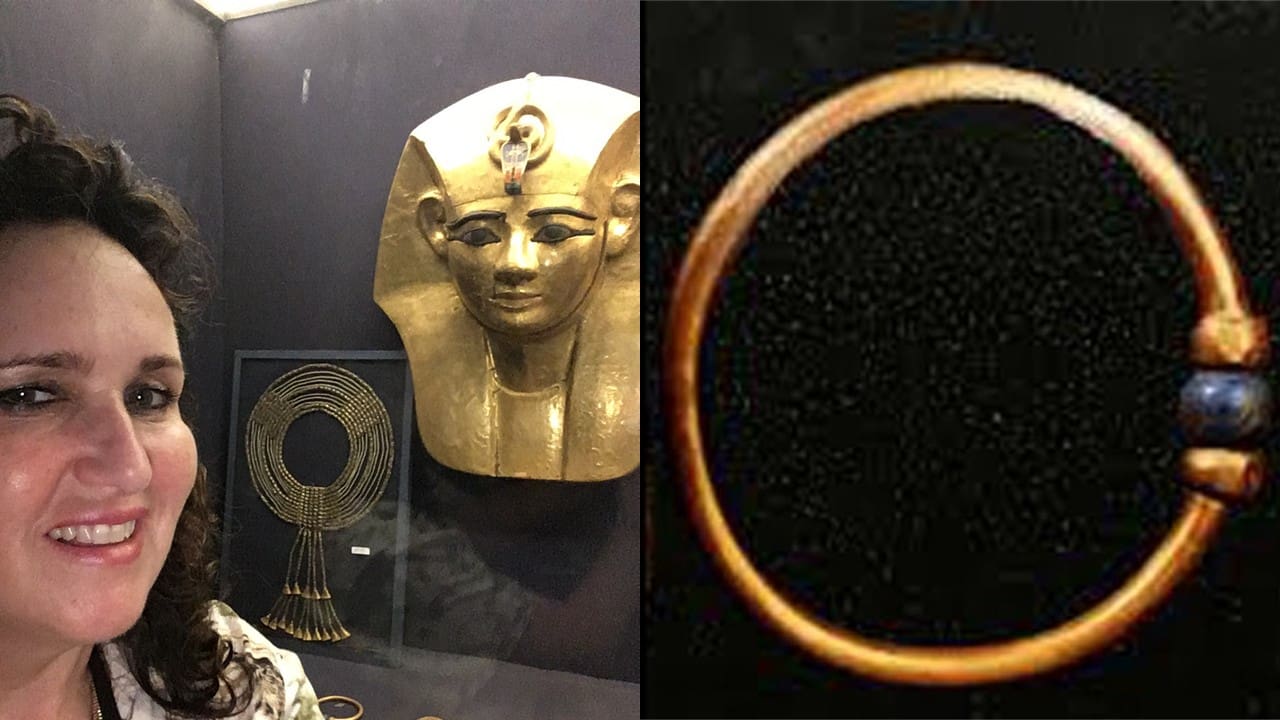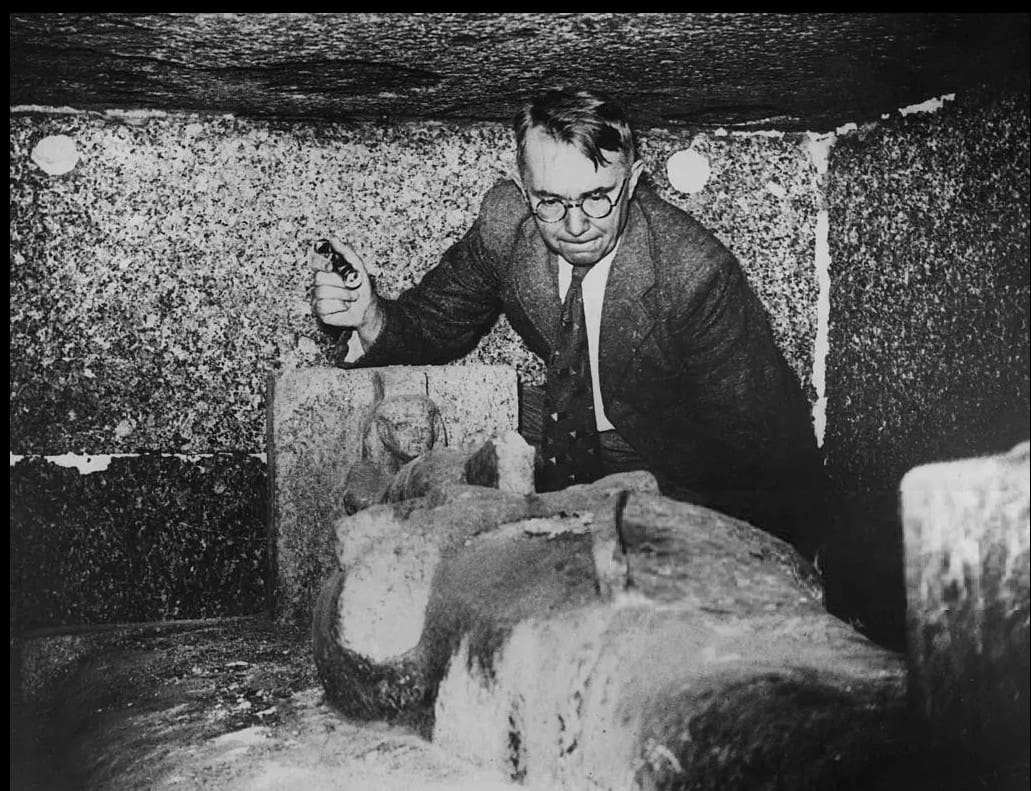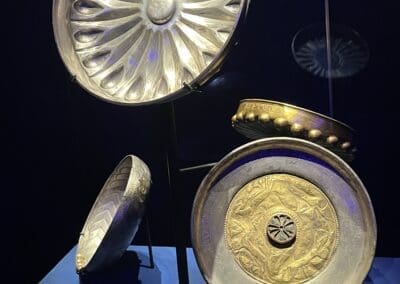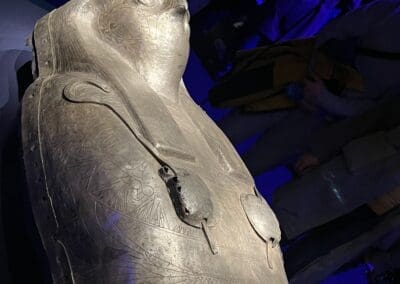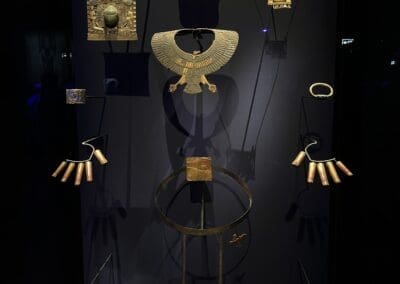By Laura Ranieri Roy
Here’s a story that might sound like a Hollywood script. A glittering jewel, a cunning inside job, and a vanishing treasure. Think The Pink Panther, To Catch a Thief, or Ocean’s 8. But this one is real—and it played out not on the silver screen, but inside the hallowed walls of the Egyptian Museum in Cairo.
On September 9, 2025, a 3,000-year-old bracelet of Pharaoh Amenemope disappeared. Not spirited away by masked burglars in the night, but stolen in broad daylight by someone inside the museum’s conservation laboratory—a trusted female conservator who allegedly used a “distraction” technique to access a secure safe.
Distraction? The details remain murky. Was it feigned illness? Did she do the old…”hey, look over there” trick??? Whatever the ruse, it worked. Within hours (and after a call to her black market jewelry friends), she smuggled the bracelet out of the museum and sold it off in Cairo’s goldsmiths’ district. Thankfully, three people are now arrested.
Melted Down for Pennies on the Dollar
The trail of this priceless artifact is both shocking and tragic. The conservator allegedly brought the bracelet to a friend in Cairo’s El-Sayeda Zeinab district, a silver shop owner. From there, it passed to a gold workshop owner in Al-Sagha, the historic goldsmiths’ district. Finally, it landed with a gold smelter employee, who melted it down to be recast into other items.
The price? A mere EGP 194,000—about $4,000 USD.
This wasn’t just any trinket. The bracelet was a solid gold band adorned with lapis lazuli, dating to around 1000 BCE. It may not have been the most elaborate piece from Tanis, but as a rare royal antiquity, its historical and cultural worth was beyond calculation.
$4,000 USD: Full Year Salary for Many in Cairo
It’s hard for many of us in the West to grasp why someone would risk their career and freedom for such a paltry sum. But in Egypt, even for an educated museum conservator, $4,000 can represent more than a year’s salary.
Here’s what conservators in Cairo typically earn:
- Mid-level conservator: EGP 15,000–30,000 per month (≈ $310–$620 USD) → $3,700–$7,400 USD per year.
- Senior / department head: EGP 400,000–630,000 per year → $8,250–$13,000 USD.
- Museum curators (related field): EGP 255,000–266,000 per year → $5,250–$5,500 USD.
In that light, the theft takes on a painful social dimension. Poverty, low wages, and limited opportunities push even skilled professionals into desperate acts.
History Repeating Itself
This is not the first time Egypt’s treasures have been plundered. In fact, the theft echoes a long tradition that stretches back to ancient times.
After the glory days of the New Kingdom, Egypt entered a period of decline. During the reign of Ramses III (12th century BCE), wars against invading “Sea Peoples” and lavish spending on mining expeditions and temple refurbishments drained the treasury. Workers in Deir el-Medina—the artisans who built the royal tombs—went unpaid and hungry. Their grievances led to history’s first recorded labor strike, preserved in the Strike Papyrus at the Oriental Institute in Chicago.
Within a century, tomb robberies swept the Valley of the Kings. Who better to know where treasures were hidden than the tomb builders themselves? Gold, silver, and jewels were looted, melted down, and sold on the black market.
Fast forward 3,000 years: a conservator, with intimate knowledge of museum procedures, targeted a bracelet. Different millennium, same story.
Amenemope: The Pharaoh Behind the Bracelet
So who was Amenemope, the king whose bracelet has now been lost?
Amenemope reigned for about nine years during Egypt’s 21st Dynasty (c. 1001–992 BCE), part of the turbulent Third Intermediate Period. His capital was Tanis, far to the north in the Nile Delta. Tanis may be familiar to moviegoers: in Indiana Jones: Raiders of the Lost Ark, it was imagined as the secret resting place of the Ark of the Covenant.
In reality, Tanis was a “second-hand capital.” Its rulers recycled monuments, obelisks, and even coffins from earlier periods. Still, Amenemope’s burial contained genuine treasures, including his gold and lapis bracelet and a beautiful gilt funerary mask.
The tomb was discovered in the late 1930s by French archaeologist Pierre Montet, who uncovered four nearly intact royal burials at Tanis: Psusennes I, Amenemope, Shoshenq II, and the general Wendjebauendjed. The find was astonishing—on par with Carter’s Tutankhamun discovery. But timing is everything. Montet’s announcement in 1939 was overshadowed by the outbreak of World War II.
Today, the treasures of Tanis form a dazzling part of the Egyptian Museum’s collection. See my video on the stunning silver coffin of Shosheq I
-

Authors Photo: Gold silver offering bowls Tanis Treasures
-

Authors photo: Silver coffin Shoshenq I
-

Author's photo: More Tanis Treasures
Cairo’s Museums in Transition
The theft also shines a spotlight on the Egyptian Museum itself. Opened in 1902 in Tahrir Square, it has long been a beloved, if somewhat chaotic, temple of antiquities. Its creaking wooden cases, echoing halls, and 19th-century charm captivate visitors—but its security measures have often lagged behind international standards.
As Egypt prepares to open the new Grand Egyptian Museum (GEM) near the Giza Pyramids, the Tahrir museum has been gradually transferring objects. Just this month, the last of Tutankhamun’s treasures—including his iconic golden mask—left Tahrir for their new home.
But in the conservation lab, where the Amenemope bracelet was kept, there were reportedly no security cameras. That absence of oversight may have enabled the theft.
Questions That Remain
The loss of the bracelet prompts some sobering reflections:
- Is the root cause of such thefts Egypt’s struggling economy, which leaves even skilled workers vulnerable to temptation?
- Should Egypt’s older museums adopt stricter protocols—environmental, security, and procedural—like those at the GEM?
- And should the world be demanding the return of antiquities to Egypt, when its institutions sometimes struggle to safeguard what they already hold?
A Loss, but Not the Last
The story of Amenemope’s bracelet is both tragic and strangely familiar. For five millennia, Egypt’s treasures have been stolen, smuggled, melted, or hidden. This theft is just the latest chapter in a cycle of plunder and preservation that seems woven into the nation’s history.
We can only mourn the loss of this piece of ancient craftsmanship—a golden circle that once adorned a pharaoh’s wrist. For a fleeting profit of $4,000, the world has been robbed of a link to its deep past.
And as history shows, it will not be the last time.
###

